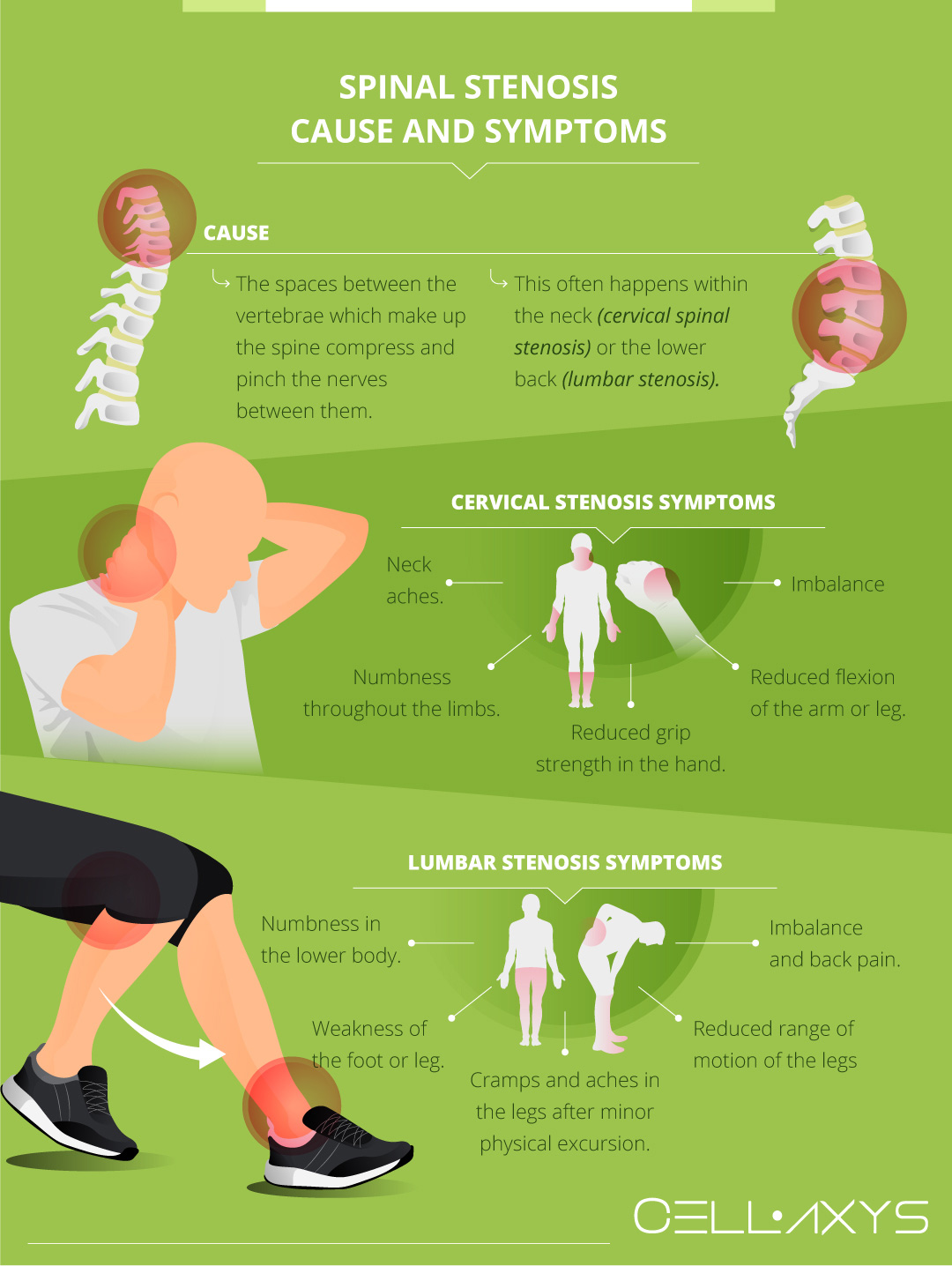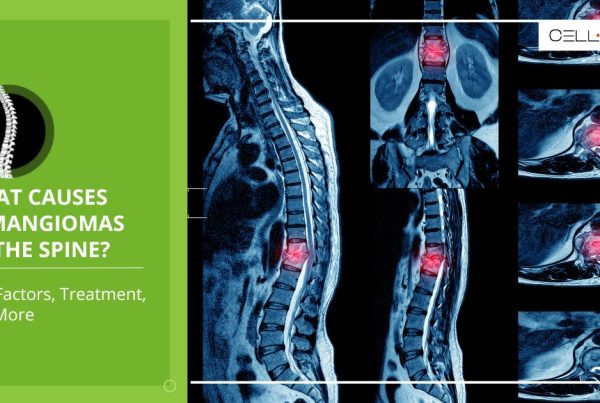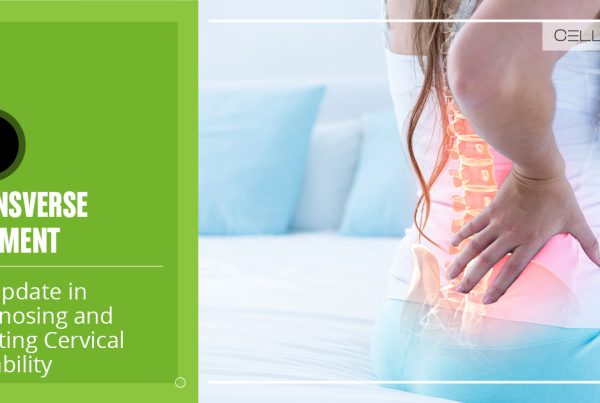Published on: November 21, 2019 | Updated on: February 3, 2025
Spinal stenosis is a condition in which the spaces within the spine narrow and put undue pressure on the nerves within. This pressure can irritate the nerves and create a range of symptoms from minor aches and tingling to chronic pain and a reduced range of motion.
Though many may not experience symptoms for some time, it is estimated that between 250,000 and 500,000 US residents have or are developing some form of spinal stenosis. The condition is more prevalent with older age – roughly 5 of every 1000 people over the age of 50 may be developing the issue.
This comes as no surprise as spinal stenosis is most typically caused by the degradation of the tissues within the spine and has even been linked to degenerative illnesses such as osteoarthritis.
Do you have spinal stenosis?
Fill out the form below to schedule your FREE virtual consultation
What Is Spinal Stenosis?
Spinal stenosis usually occurs in the neck or lower back and causes several symptoms that affect movement and general quality of life.
The spine is one of the most innervated portions of the body. It is a highway for the brain to send and receive electrical impulses from our various organs, muscles, and other tissues. Due to its prolific number of nerves, a slight malfunction or degeneration within the spine can significantly impact a person’s lifestyle.
In spinal stenosis, the spaces between the vertebrae that make up the spine compress and pinch the nerves between them. The most narrowing occurs within the neck (cervical spinal stenosis) or the lower back (lumbar stenosis). While both types share symptoms, the portions of the body in which the symptoms occur vary.
Causes of Spinal Stenosis
There are many causes of spinal canal narrowing. Usually, it occurs due to gradual changes in the spine. Sometimes, it may be due to aging or degenerative changes, and other times, underlying conditions may be the real cause.
Osteoarthritis
One of the most common causes of spinal stenosis is osteoarthritis. Osteoarthritis is a degenerative joint disease that leads to wear and tear of the cartilage joints and intervertebral discs over time. The body forms bone spurs or osteophytes to compensate for the damage.
These further get into the spinal canal, reducing the available space for the cord and nerves, which causes compression and leads to stenosis symptoms.
Herniated Disc
The intervertebral disc is more like a cushion between two vertebrae. It increases the spine’s flexibility and ability to absorb shocks.
With age or due to injuries, the disc can protrude or bulge out, causing rupture or herniation. The displaced disc presses onto the spinal cord or nerves, causing spinal stenosis.
Thickened Ligaments
Another leading cause of spinal stenosis is thick ligaments. These ligaments are the connective tissues that stabilize the spine; over time, they lose their elasticity or become swollen. This can also cause the ligaments to enter the spinal canal, narrowing the space and compressing the nerves.
Injuries
Many times, traumatic incidents like car accidents can cause a dislocation, fracture, or structural damage to the spine. This can cause bone fragments or misalign the vertebrae, which get onto the spinal canal and narrow the space.
At times, post-injury healing can also cause complex tissue formation, which can narrow down the spine space.
Congenital Stenosis
Some people are born with a narrow spinal canal or a condition called congenital spinal stenosis. Although kids do not show symptoms of it, they are susceptible to developing spinal stenosis later on in life, mainly due to the degenerative process.
However, early diagnosis is best as it can lead to appropriate pain and symptom management.
Symptoms of Spinal Stenosis

The symptoms of spinal stenosis vary depending on the patient’s condition, location of pain, and other factors. However, the main symptoms patients usually cite are:
- General weakness
- There may be pain or cramps in the legs, especially when they stand or walk, and relief can be felt by sitting or leaning forward.
- Pain or stiffness or reduced mobility overall in the affected area
- Numbness throughout the limbs (hands, feet, arms, or legs)
- Neck aches
- Reduced grip strength in the hand
- Reduced flexion of the arm or leg
- Balance and coordination issues
Lumbar Stenosis Symptoms
- Numbness in the lower body (feet or legs)
- Weakness of the foot or leg
- Cramps and aches in the legs after minor physical exertion such as walking or standing for long periods
- Legs have a reduced range of motion
- Balance and coordination issues
- Back pain
Though these symptoms are not specific to spinal stenosis, how they manifest themselves can indicate that stenosis may be the root issue. If the pain emerges and worsens over time, minor movements incite the symptoms, or if stretching of the neck or lumbar creates a flare-up, spinal stenosis is likely part of the issue.
Spinal Stenosis Diagnosis
Now, the diagnosis of spinal stenosis takes place in a series of steps. First, the doctor studies the medical history of the patient. They look into the past injuries or other symptoms they may have. This requires a physical examination where they check the patient’s body’s reflexes, mobility, and neurological response.
Past back injuries and the patient’s age are some of the most important factors to consider when diagnosing a possible case of spinal stenosis.
Past injuries can cause acute damage to the structures within the spine, which may cause malformations that lead to compressed nerves. As we age, we also lose valuable soft tissues which cushion the spine’s vertebrae from one another. As this tissue degrades, the spine compresses and can begin to pinch the nerves between each vertebra.
Physical examinations that involve stretching the spine or applying pressure to specific parts of the back may also be used. These tests aim to recreate the pain a person feels, isolate the pain to a specific portion of the back, and narrow down the possible inciting factors of the pain.
Finally, medical imaging such as MRIs, CT scans, and X-rays can provide a clearer view of the internal structures of the spine and help doctors determine their current condition and whether stenosis is the likely cause.
If spinal stenosis is the ultimate diagnosis, doctors typically recommend a range of treatment options. Based on the patient’s functional goals, doctors create a plan to determine how best to meet those goals.
Traditional Treatment Options
Generally, treatment begins with a conservative approach. For example, doctors suggest physical therapy to strengthen the muscles and improve the patient’s posture.
The patients may also be given non-steroidal anti-inflammatory medicines or muscle relaxation to reduce pain and inflammation.
If they still feel pain, they may be given epidural steroid injections, but that only offers temporary relief from the pain and swelling. However, in extreme or severe cases, surgery will be advised, like laminectomy or spinal fusion, to create space in the canal.
Conventional treatments for spinal stenosis aim to relieve pain and help patients to continue their regular activities. These treatments can be used alone or combined to achieve greater results.
Each treatment helps differently and requires a different level of engagement from the patient to be successful.
Physical Therapy for Spinal Stenosis
Physical therapies (PT) are popular for all back issues, not just stenosis. PT is simply any treatment by physical means. Massage, hot/cold therapy, guided stretching (such as yoga), exercise, and compression (binding) are some of the most popular physical therapies used to treat spinal stenosis symptoms.
These treatments are widely used because they are simple, can be done at a patient’s leisure, and are economically viable. However, they may not be as effective as other treatments in dealing with specific issues related to spinal stenosis.
For instance, degenerated tissues cannot be brought back through physical therapy, and if practiced improperly, they may escalate the issue.
Medication for Spinal Stenosis
Typically, doctors recommend the use of over-the-counter medication rather than prescription medication. Naproxen, ibuprofen, and acetaminophen are some of the most widely available drugs and help treat the pain and inflammation associated with spinal stenosis.
If these medications fail to provide relief, doctors may recommend more potent medicines aimed at reducing your perception of pain. If you regularly take other medication, mention it to your doctor so he can make the proper adjustments. Side effects can vary from person to person and may inflame the symptoms and causes of spinal stenosis.
Steroidal Injections for Spinal Stenosis
Once thought to be a miracle cure for soft tissue pains throughout the body, steroidal injections have recently come under scrutiny amongst the medical community.
The latest research shows that while these treatments can provide immediate relief from pains associated with soft tissue damage, they can also amplify the breakdown of these tissues if not used sparingly.
Surgery for Spinal Stenosis
Typically the last resort for any type of injury, doctors are especially wary of recommending surgery for spinal stenosis. Recovery periods are long, and the use of prescription pain medication in the healing process is almost always anticipated.
However, if conventional treatments fail to meet a patient’s functional goals or if the side effects and recovery periods are too much for a patient, there are many alternatives to consider.
One of the most prolific treatments is regenerative therapy: stem cell treatment and PRP therapy.
Stem Cell Therapy for Spinal Stenosis
Stem cells are the body’s raw materials or special cells that can develop into other cell types, such as muscle cells, nerve cells, or bone cells. They are important and can help repair, grow, and regenerate damaged tissues.
Key Characteristics of Stem Cells
Stem cells have the unique ability to regenerate tissues and repair damage. When introduced to damaged areas over time, they can boost healing and improve cell renewal and tissue repair.
With stem cell treatment, cancer cells can also transform into special cells like cartilage muscles or nerve cells, making them amazing treatment options for conditions otherwise deemed impossible to treat.
Benefits of Stem Cell Therapy
Stem cell therapy has many benefits, making it a number one choice and an increasingly widely used process for treating damaged or spinal cells. Some of the benefits it offers are:
- Nonsurgical Treatment: It is a minimally invasive or non-surgical option that is best for spinal stenosis.
- Pain Relief: The procedure is best for pain relief and reduces inflammation and pressure on the nerves, taking away discomfort
- Improves Healing: The procedure heals the spinal tissues, enhancing the body’s mobility and, of course, the quality of life.
- Quick Recovery: Compared to other difficult surgical methods, the procedure has a short downtime, and patients can be up on their feet sooner without post-surgical complications.
Challenges and Limitations
However, there are challenges and limitations to the process. The first is that it is a costly procedure and is usually not covered by insurance.
The treatment options are variable, with different protocols and standards offered by different providers. The process is not available worldwide; it is only limited to specific specialized clinics or centers.
While the results look promising, their effectiveness is still being researched. It is not ideal for severe spinal degeneration, where the only option left is surgery. Moreover, it carries risks, like infection, reaction to the injected cells, or improper body response.
However, these challenges are no different from any other procedure for healing or improving mobility. So, consult with a qualified specialist who can guide you through the treatment options and examine your condition before suggesting stem cell therapy.
While stem cell therapy is nothing new, recent developments have led to the discovery of stem cells known as mesenchymal stem cells. These stem cells are derived from adult tissues such as bone marrow. By extracting bone marrow directly from the patient, processing it, and reinjecting these cells into the site of an injury, the treatments will amplify the body’s natural healing processes and provide it with ample growth factors to perform repairs.
Once inside the body, the stem cells latch onto an injury and create an environment suitable for repair. From there, they send out chemical impulses that attract the body’s healing factors to the injury site and help boost their effects.
In cases of spinal stenosis, doctors can use special medical imaging procedures to place the stem cells where they will have the most impact.
Stem cell injections are beneficial over conventional treatments because they are minimally invasive and treat not only the symptoms but also the causes. As a result, these treatments last much longer than conventional treatments.
Furthermore, treatments are outpatient procedures with short recovery times. Most patients experience soreness for several days after the injection but report pain relief lasting 6 months to a year afterward.
Sources
Footnotes
- Oehme D, Goldschlager T, Rosenfeld JV, Ghosh P, Jenkin G. The role of stem cell therapies in degenerative lumbar spine disease: a review. Neurosurgical Review. 2015;38:429-45.
- Gao L, Peng Y, Xu W, He P, Li T, Lu X, Chen G. Progress in stem cell therapy for spinal cord injury. Stem Cells International. 2020;2020:1-6.
- Goldschlager T, Oehme D, Ghosh P, Zannettino A, Victor Rosenfeld J, Jenkin G. Current and future applications for stem cell therapies in spine surgery. Current Stem Cell Research & Therapy. 2013;8(5):381-93.
- Sakai D, Andersson GB. Stem cell therapy for intervertebral disc regeneration: obstacles and solutions. Nature Reviews Rheumatology. 2015;11(4):243-56.
- Urits I, Capuco A, Sharma M, Kaye AD, Viswanath O, Cornett EM, Orhurhu V. Stem cell therapies for treatment of discogenic low back pain: a comprehensive review. Current Pain and Headache Reports. 2019;23:1-2.
- Silvestro S, Bramanti P, Trubiani O, Mazzon E. Stem cells therapy for spinal cord injury: an overview of clinical trials. International Journal of Molecular Sciences. 2020;21(2):659.
References
- Spinal Stenosis. Medscape. Accessed 2/23/2024.
- What treatments are available for spinal stenosis? Medical News Today. Accessed 2/23/2024.
- Bone Injury and Repair: Abhishek Chandra. Mayo Clinic. Accessed 2/23/2024.
- Cortisone Injections | Are they a miracle cure? The Physios. Accessed 2/23/2024.
- How Often Can You Get a Cortisone Shot? VeryWell Health. Accessed 2/23/2024.
CELLAXYS does not offer Stem Cell Therapy as a cure for any medical condition. No statements or treatments presented by Cellaxys have been evaluated or approved by the Food and Drug Administration (FDA). This site contains no medical advice. All statements and opinions are provided for educational and informational purposes only.
Dr Pouya Mohajer
Author
Pouya Mohajer, M.D. is the Director of Spine and Interventional Medicine for CELLAXYS: Age, Regenerative, and Interventional Medicine Centers. He has over 20 years of experience in pain management, perioperative medicine, and anesthesiology. Dr. Mohajer founded and is the Medical Director of Southern Nevada Pain Specialists and PRIMMED Clinics. He has dedicated his career to surgical innovation and scientific advancement. More about the doctor on this page.
Dr Pejman Bady
Contributor
Dr. Pejman Bady began his career over 20 years ago in Family/Emergency Medicine, working in fast-paced emergency departments in Nevada and Kansas. He has served the people of Las Vegas as a physician for over two decades. Throughout this time, he has been met with much acclaim and is now the head of Emergency Medical Services in Nye County, Nevada. More about the doctor on this page.









